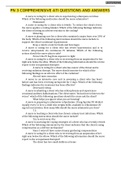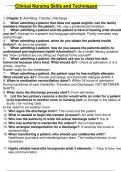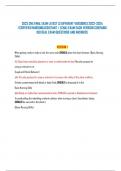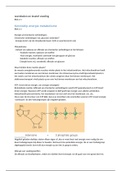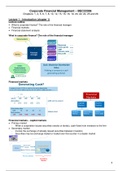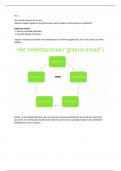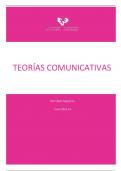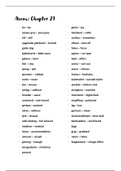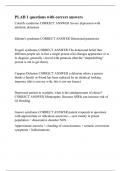Inhoudsopgave
1 What is mathematics?................................................................................................................................. 5
1.1 Nature of mathematics..................................................................................................................................5
1.2 Where does mathematics come from and what is a mathematical truth?...................................................5
1.3 Epistemological beliefs about mathematics..................................................................................................5
2 Why should it be taught?............................................................................................................................ 6
3 How to learn and teach mathematics?........................................................................................................ 6
3.1 General educational psychology perspective.................................................................................................6
3.2 Mathematics education perspective..............................................................................................................6
3.2.1 Mechanistic or skills approach...............................................................................................................7
3.2.2 Structuralistic approach..........................................................................................................................7
3.2.3 Realistic approach...................................................................................................................................7
1 Early numberical abilities and number sense...............................................................................................9
1.1 Preverbal number sense: Stanislas Dehaene – Brian Butterworth................................................................9
1.2 Foundational number sense (FONS).............................................................................................................10
1.3 Applied number sense..................................................................................................................................11
2 Conceptual analysis of components of early numerical abilities.................................................................11
2.1 Number recognition.....................................................................................................................................12
2.2 Systematic counting.....................................................................................................................................12
2.3 Awareness of the relationship between number and quantity....................................................................13
2.4 Quantity discrimination................................................................................................................................14
2.5 Understanding of different representations of number...............................................................................15
2.6 Estimation....................................................................................................................................................16
2.7 Simple arithmetic competence.....................................................................................................................16
2.8 Awareness of number patterns....................................................................................................................17
2.9 Conclusion of FONS......................................................................................................................................18
3 Emperical analysis of early numerical abilities...........................................................................................18
1 Adaptive routine expertise....................................................................................................................... 19
2 Strategy development in domain of single-digit arithmetic........................................................................19
2.1 Addition and substraction (<10)...................................................................................................................19
2.2 Addition and substraction (>10)...................................................................................................................19
2.2.1 Some major findings and issues...........................................................................................................19
2.2.2 Overlapping waves theory (Siegler)......................................................................................................20
2.3 Multiplication and division...........................................................................................................................20
2.3.1 Multiplication by the mechanistic approach........................................................................................21
2.3.2 Multiplication by the realistic approach...............................................................................................21
3 Strategy development in domain of multi-digit arithmetic.........................................................................21
1
, 3.1 Standard written algorithms........................................................................................................................22
3.2 3 algorithms for written substraction..........................................................................................................22
3.3 Mental computation....................................................................................................................................22
3.3.1 Mental computation strategies............................................................................................................22
3.3.2 Teaching for routine expertise in multi-digit mental arithmetic..........................................................23
1 Model of strategy change.......................................................................................................................... 23
1.1 Choice/no-choice method............................................................................................................................23
1.1.1 Choice method......................................................................................................................................23
1.1.2 Subject-based measure of flexibility....................................................................................................24
1.1.3 Previous studies with children..............................................................................................................24
1.2 Design...........................................................................................................................................................25
1.3 Flemish pupils’ educational background......................................................................................................25
1.4 Conditions.....................................................................................................................................................25
1.5 Analysis.........................................................................................................................................................26
1.6 Results: repertoire and frequency................................................................................................................26
1.6.1 Flexibility...............................................................................................................................................26
1.7 Conclusion....................................................................................................................................................26
1 Introduction.............................................................................................................................................. 28
1.1 Mathematical focusing tendencies..............................................................................................................28
1.2 Basic claims..................................................................................................................................................28
1.3 Mechanism of self-initiated practice............................................................................................................28
1.4 Different tendencies.....................................................................................................................................29
2 SFON......................................................................................................................................................... 29
2.1 Methodological criteria for SFON measures................................................................................................29
2.2 SFON measures............................................................................................................................................30
2.3 What do we know about SFON?..................................................................................................................30
3 SFONS....................................................................................................................................................... 31
3.1 SFONS picture task.......................................................................................................................................31
3.2 Research questions.......................................................................................................................................32
4 SFOR......................................................................................................................................................... 32
4.1 Tasks go messure SFOR................................................................................................................................32
5 SFOP......................................................................................................................................................... 33
5.1 Measures......................................................................................................................................................34
6 Conclusion and discussion......................................................................................................................... 35
6.1 Conceptual issues.........................................................................................................................................35
6.2 Measurement issues.....................................................................................................................................36
6.3 Developmental issues...................................................................................................................................36
6.3.1 Sequence..............................................................................................................................................36
6.3.2 Influencing factors................................................................................................................................36
2
, 6.3.3 Impact on general math development.................................................................................................37
6.4 Educational issues........................................................................................................................................37
1 Introduction.............................................................................................................................................. 38
2 Basic notions............................................................................................................................................. 38
2.1 Word problems.............................................................................................................................................38
2.2 Functions......................................................................................................................................................39
2.3 Word problem solving..................................................................................................................................39
3 Some research results............................................................................................................................... 40
3.1 Lacks in the content-specific knowledge......................................................................................................40
3.2 No use of valuable heuristics........................................................................................................................40
3.3 No use of valuable metacognitive skills.......................................................................................................40
3.4 Inadequate conceptions and beliefs.............................................................................................................41
4 Causes...................................................................................................................................................... 41
4.1 Nature of problems......................................................................................................................................42
4.2 Ways in which problems are conceived.......................................................................................................42
5 Remedies.................................................................................................................................................. 43
5.1 Goals.............................................................................................................................................................43
5.2 Major pillars.................................................................................................................................................44
5.3 Structure of lesson series..............................................................................................................................44
5.4 Research design (not important)..................................................................................................................45
5.5 Results..........................................................................................................................................................45
5.6 Important barriers........................................................................................................................................45
6 Mathematical modelling........................................................................................................................... 45
6.1 More extended model..................................................................................................................................46
1 Definitions & concepts.............................................................................................................................. 47
1.1 Numbers: changes in meaning.....................................................................................................................47
2 Rational numbers in the curriculum........................................................................................................... 48
2.1 Curriculum in primary school (Flemish)........................................................................................................48
2.2 Curriculum in secondary school (Flemish)....................................................................................................48
2.3 How do children do?.....................................................................................................................................48
3 Transition from natural to rational numbers.............................................................................................. 48
3.1 Meaning of operations.................................................................................................................................48
4 Theory about knowledge and learning (conceptual change theory)............................................................49
4.1 Continuous discontinuous...........................................................................................................................49
4.2 Naïve conceptions (=conceptual change theory).........................................................................................49
3
, 5 Exemplary elaboration in research about rational numbers.......................................................................50
5.1 Conceptual change in math.........................................................................................................................50
5.2 Early number knowledge..............................................................................................................................50
5.3 Initial instruction..........................................................................................................................................50
5.4 Consequence................................................................................................................................................50
5.5 From a discrete to a dense number line.......................................................................................................50
4
1 What is mathematics?................................................................................................................................. 5
1.1 Nature of mathematics..................................................................................................................................5
1.2 Where does mathematics come from and what is a mathematical truth?...................................................5
1.3 Epistemological beliefs about mathematics..................................................................................................5
2 Why should it be taught?............................................................................................................................ 6
3 How to learn and teach mathematics?........................................................................................................ 6
3.1 General educational psychology perspective.................................................................................................6
3.2 Mathematics education perspective..............................................................................................................6
3.2.1 Mechanistic or skills approach...............................................................................................................7
3.2.2 Structuralistic approach..........................................................................................................................7
3.2.3 Realistic approach...................................................................................................................................7
1 Early numberical abilities and number sense...............................................................................................9
1.1 Preverbal number sense: Stanislas Dehaene – Brian Butterworth................................................................9
1.2 Foundational number sense (FONS).............................................................................................................10
1.3 Applied number sense..................................................................................................................................11
2 Conceptual analysis of components of early numerical abilities.................................................................11
2.1 Number recognition.....................................................................................................................................12
2.2 Systematic counting.....................................................................................................................................12
2.3 Awareness of the relationship between number and quantity....................................................................13
2.4 Quantity discrimination................................................................................................................................14
2.5 Understanding of different representations of number...............................................................................15
2.6 Estimation....................................................................................................................................................16
2.7 Simple arithmetic competence.....................................................................................................................16
2.8 Awareness of number patterns....................................................................................................................17
2.9 Conclusion of FONS......................................................................................................................................18
3 Emperical analysis of early numerical abilities...........................................................................................18
1 Adaptive routine expertise....................................................................................................................... 19
2 Strategy development in domain of single-digit arithmetic........................................................................19
2.1 Addition and substraction (<10)...................................................................................................................19
2.2 Addition and substraction (>10)...................................................................................................................19
2.2.1 Some major findings and issues...........................................................................................................19
2.2.2 Overlapping waves theory (Siegler)......................................................................................................20
2.3 Multiplication and division...........................................................................................................................20
2.3.1 Multiplication by the mechanistic approach........................................................................................21
2.3.2 Multiplication by the realistic approach...............................................................................................21
3 Strategy development in domain of multi-digit arithmetic.........................................................................21
1
, 3.1 Standard written algorithms........................................................................................................................22
3.2 3 algorithms for written substraction..........................................................................................................22
3.3 Mental computation....................................................................................................................................22
3.3.1 Mental computation strategies............................................................................................................22
3.3.2 Teaching for routine expertise in multi-digit mental arithmetic..........................................................23
1 Model of strategy change.......................................................................................................................... 23
1.1 Choice/no-choice method............................................................................................................................23
1.1.1 Choice method......................................................................................................................................23
1.1.2 Subject-based measure of flexibility....................................................................................................24
1.1.3 Previous studies with children..............................................................................................................24
1.2 Design...........................................................................................................................................................25
1.3 Flemish pupils’ educational background......................................................................................................25
1.4 Conditions.....................................................................................................................................................25
1.5 Analysis.........................................................................................................................................................26
1.6 Results: repertoire and frequency................................................................................................................26
1.6.1 Flexibility...............................................................................................................................................26
1.7 Conclusion....................................................................................................................................................26
1 Introduction.............................................................................................................................................. 28
1.1 Mathematical focusing tendencies..............................................................................................................28
1.2 Basic claims..................................................................................................................................................28
1.3 Mechanism of self-initiated practice............................................................................................................28
1.4 Different tendencies.....................................................................................................................................29
2 SFON......................................................................................................................................................... 29
2.1 Methodological criteria for SFON measures................................................................................................29
2.2 SFON measures............................................................................................................................................30
2.3 What do we know about SFON?..................................................................................................................30
3 SFONS....................................................................................................................................................... 31
3.1 SFONS picture task.......................................................................................................................................31
3.2 Research questions.......................................................................................................................................32
4 SFOR......................................................................................................................................................... 32
4.1 Tasks go messure SFOR................................................................................................................................32
5 SFOP......................................................................................................................................................... 33
5.1 Measures......................................................................................................................................................34
6 Conclusion and discussion......................................................................................................................... 35
6.1 Conceptual issues.........................................................................................................................................35
6.2 Measurement issues.....................................................................................................................................36
6.3 Developmental issues...................................................................................................................................36
6.3.1 Sequence..............................................................................................................................................36
6.3.2 Influencing factors................................................................................................................................36
2
, 6.3.3 Impact on general math development.................................................................................................37
6.4 Educational issues........................................................................................................................................37
1 Introduction.............................................................................................................................................. 38
2 Basic notions............................................................................................................................................. 38
2.1 Word problems.............................................................................................................................................38
2.2 Functions......................................................................................................................................................39
2.3 Word problem solving..................................................................................................................................39
3 Some research results............................................................................................................................... 40
3.1 Lacks in the content-specific knowledge......................................................................................................40
3.2 No use of valuable heuristics........................................................................................................................40
3.3 No use of valuable metacognitive skills.......................................................................................................40
3.4 Inadequate conceptions and beliefs.............................................................................................................41
4 Causes...................................................................................................................................................... 41
4.1 Nature of problems......................................................................................................................................42
4.2 Ways in which problems are conceived.......................................................................................................42
5 Remedies.................................................................................................................................................. 43
5.1 Goals.............................................................................................................................................................43
5.2 Major pillars.................................................................................................................................................44
5.3 Structure of lesson series..............................................................................................................................44
5.4 Research design (not important)..................................................................................................................45
5.5 Results..........................................................................................................................................................45
5.6 Important barriers........................................................................................................................................45
6 Mathematical modelling........................................................................................................................... 45
6.1 More extended model..................................................................................................................................46
1 Definitions & concepts.............................................................................................................................. 47
1.1 Numbers: changes in meaning.....................................................................................................................47
2 Rational numbers in the curriculum........................................................................................................... 48
2.1 Curriculum in primary school (Flemish)........................................................................................................48
2.2 Curriculum in secondary school (Flemish)....................................................................................................48
2.3 How do children do?.....................................................................................................................................48
3 Transition from natural to rational numbers.............................................................................................. 48
3.1 Meaning of operations.................................................................................................................................48
4 Theory about knowledge and learning (conceptual change theory)............................................................49
4.1 Continuous discontinuous...........................................................................................................................49
4.2 Naïve conceptions (=conceptual change theory).........................................................................................49
3
, 5 Exemplary elaboration in research about rational numbers.......................................................................50
5.1 Conceptual change in math.........................................................................................................................50
5.2 Early number knowledge..............................................................................................................................50
5.3 Initial instruction..........................................................................................................................................50
5.4 Consequence................................................................................................................................................50
5.5 From a discrete to a dense number line.......................................................................................................50
4

